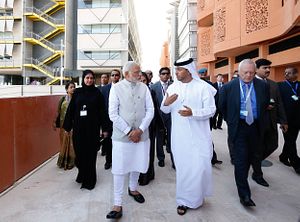On February 10, Abu Dhabi awarded an Indian consortium a 10 percent stake in one of its offshore oil concession areas. This announcement is significant as it marks India’s maiden entry into the Gulf’s upstream hydrocarbons sector.
The $600 million deal was facilitated by a recent upswing in political ties, following a spate of reciprocal visits by the UAE-Indian leadership and the consequent flow of bilateral ties.
In 2015, after becoming the first Indian prime minister to visit the UAE in 34 years, Narendra Modi returned on February 10-11 for the World Government Summit in Dubai.
In the meantime, the UAE’s de facto leader, Abu Dhabi Crown Prince and Deputy Supreme Commander of the UAE Armed Forces H.H. Sheikh Mohammed bin Zayed Al Nahyan, visited India in 2016 and 2017.
This momentum in bilateral ties helped surpass the traditional areas of collaboration – oil, trade and expatriate workers. To tackle contemporary challenges of mutual interest, the two countries signed the “Comprehensive Strategic Partnership Agreement” last year. This newfound government-to-government camaraderie and strengthening of ties allows the two countries to not only focus on new economic opportunities like food security and frontier science, but also helps them tackle their mutual security concerns in the Middle East and South Asia.
This will be enabled through improved tactical defense cooperation, joint military exercises and training, naval collaboration, partnerships in defense production, and combined action against religious extremism.
While this agenda will evolve over the next few years, it is worth exploring the possibility of converting the strategic bilateral association into tactical multilateral partnerships in certain economic and security domains.
In the current context, the rationale for multilateralism is that many of the UAE’s and India’s individual interests or joint concerns are unlikely to be optimally addressed by mere bilateral cooperation mechanisms.
While the immediate economic, political, and strategic needs could be met by pursuing bilateral track, long-term interests – which often depend on a third country or more – this is best tackled through a multilateral strategy. Pooling of resources, ideas, and efforts would not only be cost-effective and efficient, but could possibly yield better results as well.
To this end, the UAE and India are engaged in separate multilateral partnerships with various countries. They are also part of several multilateral forums, but many are too global in nature to promote their common interests nearer to home.
Instead they could focus on collaborating in regional organizations to promote multilateral engagement, like the Indian Ocean Rim Association (IORA) and the Indian Ocean Naval Symposium. The IORA is crucial to promoting the economic interests of 21 member countries, including the UAE and India, and to safeguarding mercantile shipping lanes from piracy.
Such an association would gel with India’s vision of SAGAR (Security and Growth for All in the Region). This promotes an ocean-based “blue economy,” wherein sustainable economic development is linked to security.
Another potential area is the defense sector. Both the UAE and India are negotiating with France to purchase Rafale fighter jets. This offers a chance for Paris-supervised regional manufacturing of spare parts and collaboration in aviation software technology that could be cost-effective for both.
Recently, New Delhi’s proactive diplomacy has sought to expand and intensify ties in South, West, East and Central Asia, which offers the UAE scope to enhance its own interests by teaming up with India. Opportunities include the following:
The UAE could consider investment in India’s North-South Transport Corridor (NSTC), a network of ship, rail, and road routes between India and Europe, via the Middle East, Central Asia, and Russia. It links the Indian Ocean and Gulf with the Caspian Sea, making the current routes shorter and reducing transport costs. Either Afghanistan or Central Asian countries, where the UAE has stakes, could become potential venues for multilateral cooperation.
Beyond the potential NSTC opportunity in Afghanistan, the UAE and India are also committed to the war-torn country’s stability and welfare, paving the way for cooperation on combating terrorism and coordinating their development assistance and infrastructure projects, thus strengthening the Afghan government.
The UAE and India could also team up in Africa by combining their strengths of wealth and technological expertise to augment, for example, telemedicine and food production and storage facilities, which have great potential to improve the quality of living in remote parts of the continent.
India is also part of the Japan-promoted “Asia-Africa Growth Corridor” or “Freedom Corridor,” connecting the Bay of Bengal and the South China Sea, a potential point of interest to the UAE given its recent focus on expanding business and strategic opportunities in Africa.
India-Japan joint ventures also open the door for the UAE to promote and partake in engagements arising from the recent quadrilateral cooperation among the mainstream Indo-Pacific countries, including Australia and the United States.
Together, the quest to advance UAE-India bilateral ties through some of these partnerships also adds value to South-South cooperation and contributes to partially fulfilling the United Nations Sustainable Development Goals.
Finally, there is also the opportunity for both countries to work with other like-minded countries to draw the contours of a more effective security architecture for the region.
UAE-India relations have a newfound level of strategic depth, and there remains enormous potential for collaboration on multilateral initiatives. While it is every country’s sovereign right to pursue the strategy that suits it best, there is little to argue against pooling of opportunities and resources, particularly when shared interests pave the way for discernible results.
There is an increasing mutual recognition between Abu Dhabi and New Delhi, which, along with other strategic partners, are poised to leverage multilateralism to improve economic efficiency, enhance international cooperation, and contribute to peace and security in the region. The effects are not instantaneous, but the two countries are demonstrating the value and benefit of an approach that focuses on commercial, military, and diplomatic partnership supporting mutual interests and regional stability.
Dr. N. Janardhan is Senior Research Fellow, Gulf-Asia Programme, Emirates Diplomatic Academy, and Honorary Fellow, University of Exeter.

































